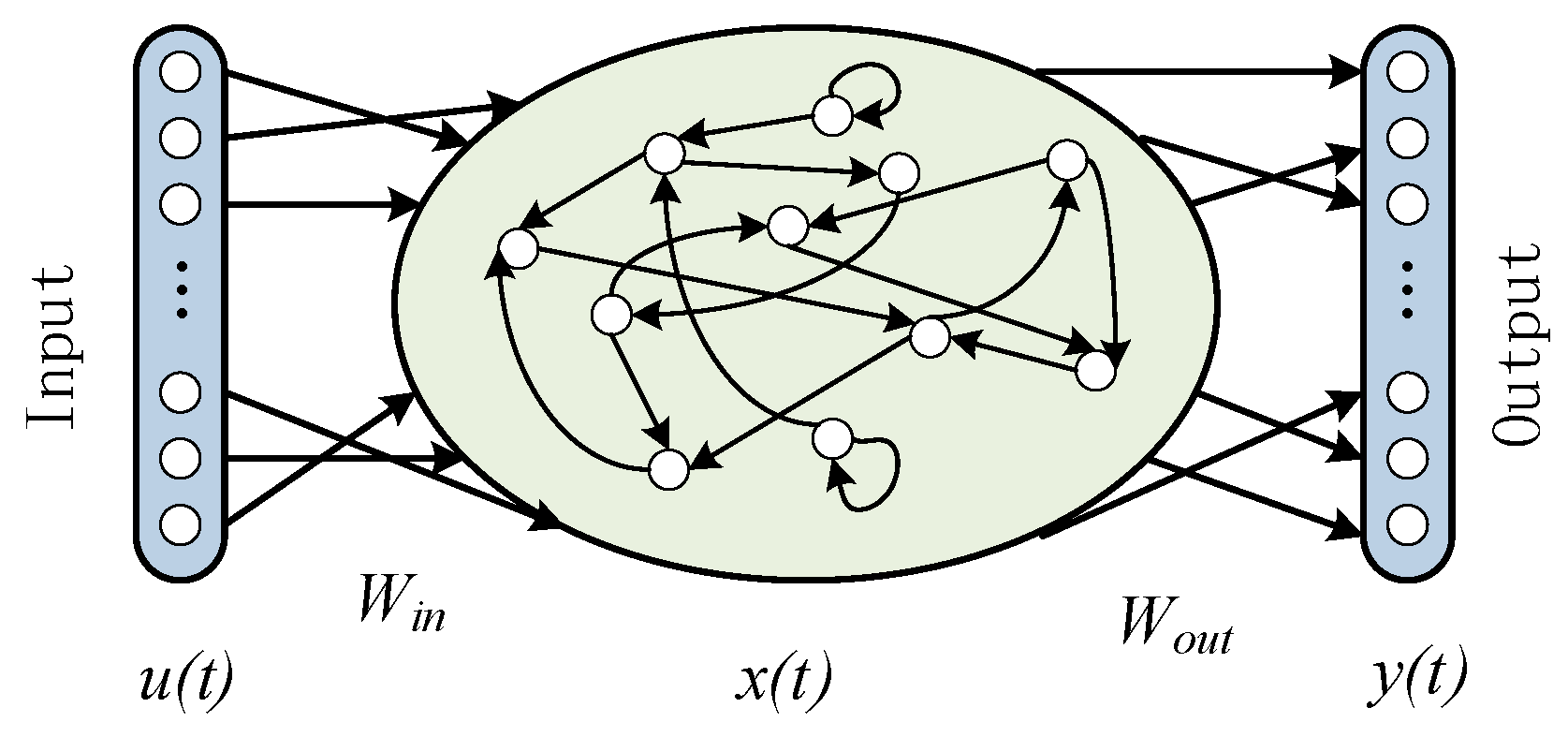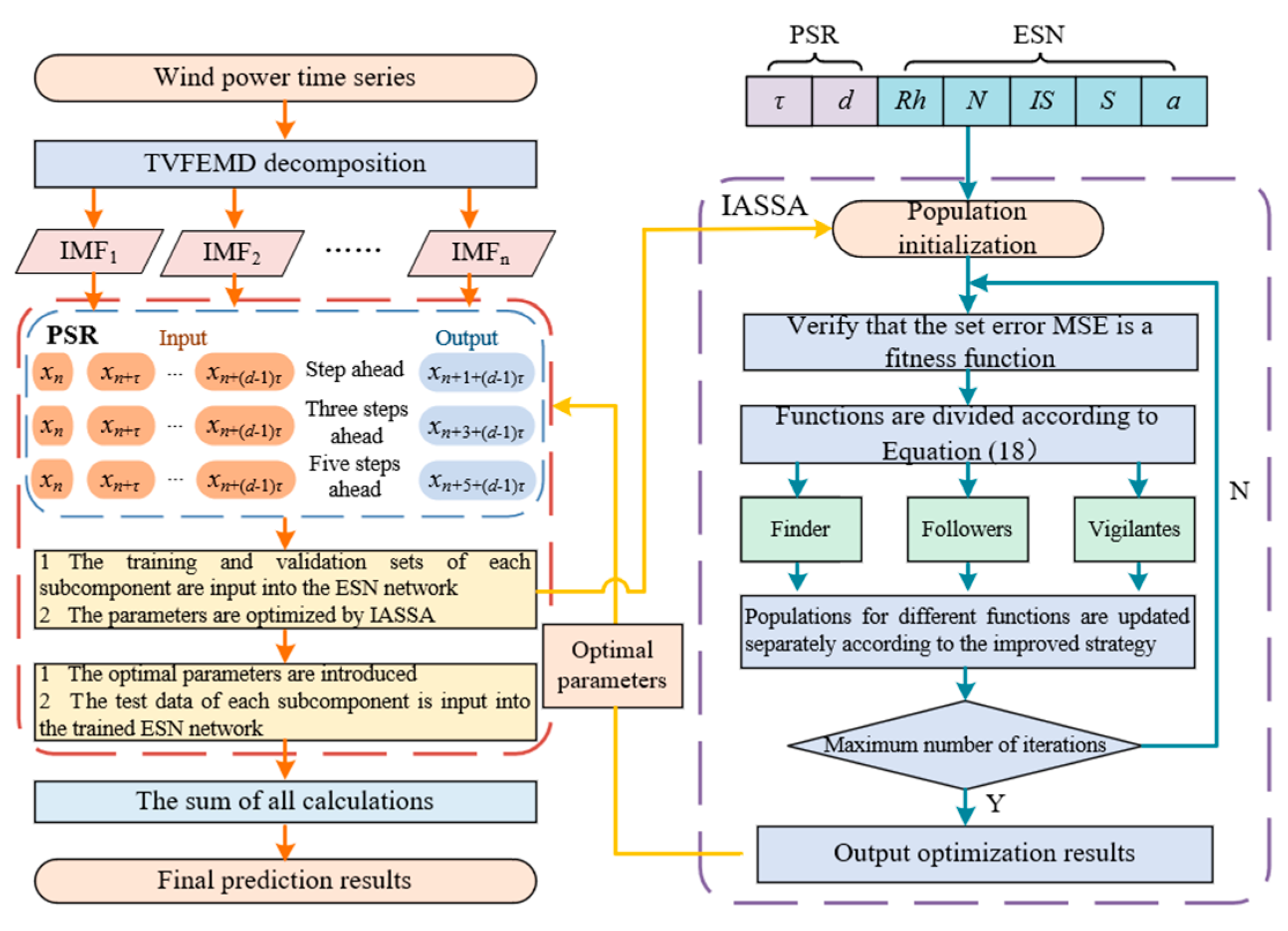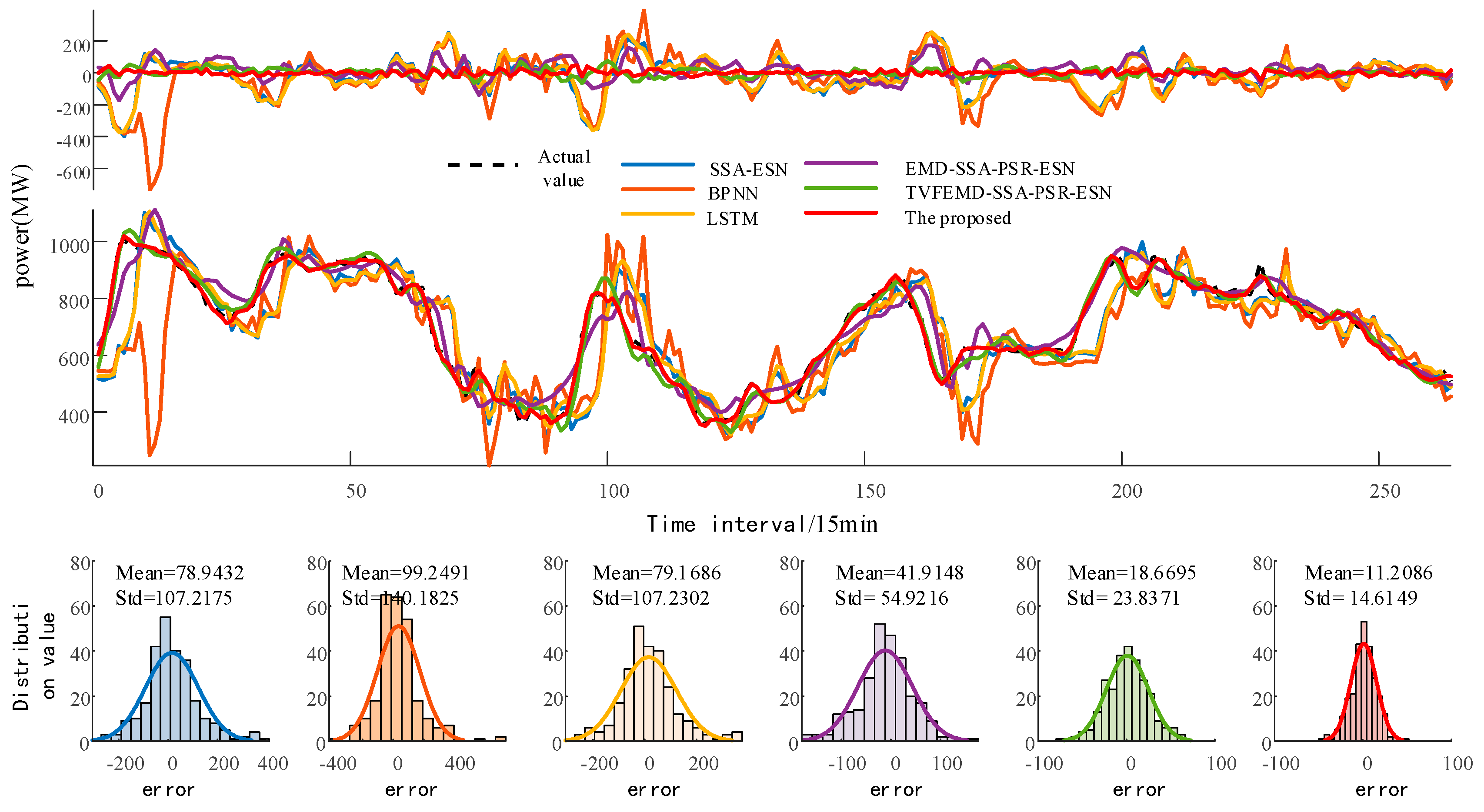Multistep Wind Power Prediction Using Time-Varying Filtered Empirical Modal Decomposition and Improved Adaptive Sparrow Search Algorithm-Optimized Phase Space Reconstruction–Echo State Network
Abstract
1. Introduction
2. Fundamental Principle
2.1. Time-Varying Filtering-Based Empirical Mode Decomposition
2.2. Phase Space Reconstruction
2.3. Echo State Network
3. IASSA Algorithm and its Optimization Strategy
3.1. Sparrow Search Algorithm
3.2. Improved Adaptive Sparrow Search Algorithm
3.3. Algorithm Evaluation
4. Wind Power Prediction Model Design
- (1)
- Raw wind power data were collected.
- (2)
- The original wind power time series was divided into a series of subsequences by using TVFEMD.
- (3)
- All subsequences were converted into phase space matrices by using PSR and divided into the training set, validation set, and test set.
- (4)
- The ESN model was trained using the training set to verify that the RMSE of the set was the minimum, and all parameters in PSR and ESN were optimized synchronously using IASSA.
- (5)
- The optimized optimal parameters were introduced into PSR-ESN, and the test set was ran in order to obtain the prediction results of the subseries.
- (6)
- The prediction results of all subcomponents were accumulated to obtain the final wind power prediction results.
5. Case Analysis
5.1. Description of the Experiment
5.2. Data Decomposition and Normalization
5.3. Prediction Results and Analysis
- A comparison of the evaluation indicators RMSE, MAE, and MAPE of the SSA-ESN, BPNN, and LSTM models revealed that SSA-ESN had better prediction performance. In the 1-step, 3-step, and 5-step predictions, compared with BPNN and LSTM, the RMSE decreased by 3.2872 and 9.8666 (1 step), 7.8863 and 1.6156 (3 steps), and 30.1470 and 0.1169 (5 steps), respectively; the MAE decreased by 2.0291 and 11.6219 (1 step), 4.4120 and 1.2362 (3 steps), and 15.9460 and 0.5530 (5 steps); and the MAPE decreased by 0.3132 and 1.8950 (1 step), 0.6080 and 0.1861 (3 steps), and 2.2387 and 0.2191 (5 steps), respectively.
- A comparative analysis of the models SSA-ESN, EMD-SSA-PSR–ESN, and TVFEMD-SSA-PSR–ESN revealed that the prediction performance of the model were greatly improved upon the addition of the signal decomposition method and PSR-ESN. The RMSE decreased by 17.8790 (1 step), 19.5499 (3 steps), and 32.8191 (5 steps); the MAE decreased by 12.0532 (1 step), 14.1699 (3 steps), and 24.0338 (5 steps); and the MAPE decreased by 1.9660 (1 step), 2.1109 (3 steps), and 3.5927 (5 steps).
- Due to the drawbacks of the traditional SSA optimization methods, as well as PSR and ESN, requiring many parameters, SSA often falls into local optimal solutions. Therefore, in this study, the proposed IASSA was combined with PSR and ESN on the basis of TVFEMD to strengthen the prediction ability of the model through better parameter optimization performance. Comparing the TVFEMD-SSA-PSR-ESN model with the proposed model, the RMSE decreased by 1.2118 (1 step), 3.3657 (3 steps), and 9.3887 (5 steps); the MAE decreased by 0.9632, 2.4975, and 7.4163; and the MAPE decreased by 0.1258 (1 step), 0.3932 (3 steps), and 1.3014 (5 steps), respectively. Thus, the optimization performance of the IASSA not only has a certain effect on the classical test function but also exhibits good capacity to solve the actual parameter optimization problem.
6. Conclusions
- (1)
- A comparison of the performance of EMD and TVFEMD decomposition of the original wind power time series revealed that TVFEMD, combined with the prediction model, yielded an improved prediction effect: the difference was expressed via number of steps, namely, 1 step, 3 steps, and 5 steps, and the effect was more obvious.
- (2)
- Compared with the original SSA, the proposed IASSA exhibited a better optimization performance in the classical test function and the actual prediction application. The accuracy was effectively improved in the three performance evaluations of root mean-square error (RMSE), mean absolute error (MAE) and mean absolute proportional error (MAPE).
- (3)
- Compared with six existing models, the experimental analysis of multistep prediction revealed that the proposed prediction model combining TVFEMD, PSR, ESN, and IASSA synchronous optimization strategies were able to effectively improve the prediction accuracy.
Author Contributions
Funding
Institutional Review Board Statement
Informed Consent Statement
Data Availability Statement
Acknowledgments
Conflicts of Interest
References
- Vahidzadeh, M.; Markfort, C.D. Modified power curves for prediction of power output of wind farms. Energies 2019, 12, 1805. [Google Scholar] [CrossRef]
- Yang, N.; Dong, Z.; Wu, L.; Zhang, L.; Shen, X.; Chen, D.; Zhu, B.; Liu, Y. A comprehensive review of security-constrained unit commitment. J. Mod. Power Syst. Clean Energy 2022, 10, 562–576. [Google Scholar] [CrossRef]
- Yang, N.; Qin, T.; Wu, L.; Huang, Y.; Huang, Y.; Xing, C.; Zhang, L.; Zhu, B. A multi-agent game based joint planning approach for electricity-gas integrated energy systems considering wind power uncertainty. Electr. Power Syst. Res. 2021, 204, 107673. [Google Scholar] [CrossRef]
- Xu, P.; Fu, W.; Lu, Q.; Zhang, S.; Wang, R.; Meng, J. Stability analysis of hydro-turbine governing system with sloping ceiling tailrace tunnel and upstream surge tank considering nonlinear hydro-turbine characteristics. Renew. Energy 2023, 210, 556–574. [Google Scholar] [CrossRef]
- Zhang, Y.; Wei, L.; Fu, W. Secondary frequency control strategy considering DoS attacks for MTDC sys-tem. Electr. Power Syst. Res. 2023, 214, 108888. [Google Scholar] [CrossRef]
- Zhang, Y.; Xie, X.; Fu, W. An Optimal Combining Attack Strategy Against Economic Dispatch of In-tegrated Energy System. IEEE Trans. Circuits Syst. II Express Briefs 2023, 70, 246–250. [Google Scholar]
- Ding, T.; Yang, M.; Yu, Y.; Si, Z.; Zhang, Q. Short-term Wind Power Integration Prediction Method Based on Error Correction. High Volt. Eng. 2022, 48, 488–496. [Google Scholar]
- Hu, W.; Zhang, X.; Li, Z.E. Short-term load forecasting based on an optimized VMD-mRMR-LSTM model. Power Syst. Protect. Control 2022, 50, 88–97. [Google Scholar]
- Fang, P.; Fu, W.; Wang, K.; Xiong, D.; Zhang, K. A compositive architecture coupling outlier correction, EWT, nonlinear Volterra multi-model fusion with multi-objective optimization for short-term wind speed forecasting. Appl. Energy 2022, 307, 118191. [Google Scholar]
- Hu, S.; Xiang, Y.; Shen, X.; Liu, J.; Liu, J.; Li, J. Wind power prediction model considering meteorological factor and spatial correlation of wind speed. Autom. Elec. Power Syst. 2021, 45, 28–36. [Google Scholar]
- Cheng, L.; Zang, H.; Xu, Y.; Wei, Z.; Sun, G. Augmented convolutional network for wind power prediction: A new recurrent architecture design with spatial-temporal image inputs. IEEE Trans. Ind. Inform. 2021, 17, 6981–6993. [Google Scholar] [CrossRef]
- Yang, M.; Dong, H. Short-term Wind Power Interval Prediction Based on Wind Speed of Numerical Weather Prediction and Monte Carlo Method. Power Syst. Autom. 2021, 45, 79–85. [Google Scholar]
- Liu, M.D.; Ding, L.; Bai, Y.L. Application of hybrid model based on empirical mode decomposition, novel recurrent neural networks and the ARIMA to wind speed prediction. Energy Convers. Manag. 2021, 233, 113917. [Google Scholar] [CrossRef]
- Dong, Y.; Ma, S.; Zhang, H.; Yang, G. Wind Power Prediction Based on Multi-class Autoregressive Moving Average Model with Logistic Function. J. Mod. Power Syst. Clean Energy 2022, 10, 1184–1193. [Google Scholar] [CrossRef]
- Wang, X.; Li, J.; Shao, L.; Liu, H.; Ren, L.; Zhu, L. Short-Term Wind Power Prediction by an Extreme Learning Machine Based on an Improved Hunter–Prey Optimization Algorithm. Sustainability 2023, 15, 991. [Google Scholar] [CrossRef]
- Tian, W.; Bao, Y.; Liu, W. Wind Power Forecasting by the BP Neural Network with the Support of Machine Learning. Math. Probl. Eng. 2022, 2022, 7952860. [Google Scholar] [CrossRef]
- van Heerden, L.; Vermeulen, H.; van Staden, C. Wind Power Forecasting using Hybrid Recurrent Neural Networks with Empirical Mode Decomposition. In Proceedings of the 2022 IEEE International Conference on Environment and Electrical Engineering and 2022 IEEE Industrial and Commercial Power Systems Europe (EEEIC/I&CPS Europe), Prague, Czech Republic, 28 June–1 July 2022; pp. 1–6. [Google Scholar] [CrossRef]
- Wang, D.; Cui, X.; Niu, D. Wind Power Forecasting Based on LSTM Improved by EMD-PCA-RF. Sustainability 2022, 14, 7307. [Google Scholar] [CrossRef]
- Fu, W.; Jiang, X.; Li, B.; Tan, C. Rolling bearing fault diagnosis based on 2D time-frequency images and data augmentation technique. Meas. Sci. Technol. 2023, 34, 045005. [Google Scholar] [CrossRef]
- Ding, M.; Zhou, H.; Xie, H.; Wu, M.; Nakanishi, Y.; Yokoyama, R. A gated recurrent unit neural networks based wind speed error correction model for short-term wind power forecasting. Neurocomputing 2019, 365, 54–61. [Google Scholar] [CrossRef]
- Ruiz-Aguilar, J.J.; Turias, I.; González-Enrique, J.; Urda, D.; Elizondo, D. A permutation entropy-based EMD–ANN forecasting ensemble approach for wind speed prediction. Neural Comput. Appl. 2021, 33, 2369–2391. [Google Scholar] [CrossRef]
- Zhang, C.; Ma, H.; Hua, L.; Sun, W.; Nazir, M.S.; Peng, T. An evolutionary deep learning model based on TVFEMD, improved sine cosine algorithm, CNN and BiLSTM for wind speed prediction. Energy 2022, 254, 124250. [Google Scholar] [CrossRef]
- Liu, Y.; Zhao, Q. Ultra-short-term power load forecasting based on cluster empirical mode decomposition of CNN-LSTM. Power Syst. Technol. 2021, 45, 4444–4451. [Google Scholar]
- Wang, R.; Li, C.; Fu, W.; Tang, G. Deep learning method based on gated recurrent unit and variational mode decomposition for short-term wind power interval prediction. IEEE Trans. Neural Netw. Learn. Syst. 2020, 31, 3814–3827. [Google Scholar] [CrossRef] [PubMed]
- Yang, N.; Yang, C.; Wu, L.; Shen, X.; Jia, J.; Li, Z.; Chen, D.; Zhu, B.; Liu, S. Intelligent data-driven decision-making method for dynamic multisequence: An E-seq2seq-based SCUC expert system. IEEE Trans. Ind. Inform. 2022, 18, 3126–3137. [Google Scholar] [CrossRef]
- Yang, N.; Yang, C.; Xing, C.; Ye, D.; Jia, J.; Chen, D.; Shen, X.; Huang, Y.; Zhang, L.; Zhu, B. Deep learning-based SCUC decision-making: An intelligent data-driven approach with self-learning capabilities. IET Gener. Transm. Distrib. 2022, 16, 629–640. [Google Scholar] [CrossRef]
- Hu, H.; Wang, L.; Tao, R. Wind speed forecasting based on variational mode decomposition and improved echo state network. Renew. Energy 2021, 164, 729–751. [Google Scholar] [CrossRef]
- Xu, M.; Wang, Y. Time series prediction based on improved differential evolution and echo state network. Chin. J. Autom. 2021, 47, 1589–1597. [Google Scholar]
- Wang, Z.; Wang, C.; Chen, L.; Li, G.; Gao, J. Photovoltaic power combined prediction based on ensemble empirical mode decomposition and deep learning. High Volt. Eng. 2022, 48, 4133–4142. [Google Scholar] [CrossRef]
- Li, L.L.; Liu, Z.F.; Tseng, M.L.; Jantarakolica, K.; Lim, M.K. Using enhanced crow search algorithm optimization-extreme learning machine model to forecast short-term wind power. Expert Syst. Appl. 2021, 184, 115579. [Google Scholar] [CrossRef]
- Samadianfard, S.; Hashemi, S.; Kargar, K.; Izadyar, M.; Mostafaeipour, A.; Mosavi, A.; Nabipour, N.; Shamshirband, S. Wind speed prediction using a hybrid model of the multi-layer perceptron and whale optimization algorithm. Energy Rep. 2020, 6, 1147–1159. [Google Scholar] [CrossRef]
- Du, M. Improving LSTM Neural Networks for Better Short-Term Wind Power Predictions. In Proceedings of the 2019 IEEE 2nd International Conference on Renewable Energy and Power Engineering (REPE), Toronto, ON, Canada, 4–6 November 2019; pp. 105–109. [Google Scholar] [CrossRef]
- Xiong, D.; Fu, W.; Wang, K.; Fang, P.; Chen, T.; Zou, F. A blended approach incorporating TVFEMD, PSR, NNCT-based multi-model fusion and hierarchy-based merged optimization algorithm for multi-step wind speed prediction. Energy Convers. Manag. 2021, 230, 113680. [Google Scholar] [CrossRef]
- Fu, W.; Zhang, K.; Wang, K.; Wen, B.; Fang, P.; Zou, F. A hybrid approach for multi-step wind speed forecasting based on two-layer decomposition, improved hybrid DE-HHO optimization and KELM. Renew. Energy 2021, 164, 211–229. [Google Scholar] [CrossRef]
- Ju, Y.; Qi, L.; Liu, S. Short-term wind power forecasting based on improved crow search algorithm and ESN neural network. Power Syst. Protect. Control 2019, 47, 58–64. [Google Scholar]
- Xue, J.; Shen, B. A novel swarm intelligence optimization approach: Sparrow search algorithm. Syst. Sci. Control Eng. 2020, 8, 22–34. [Google Scholar] [CrossRef]
- Ma, J.; Hao, Z.; Sun, W. Enhancing sparrow search algorithm via multi-strategies for continuous optimization problems. Inf. Process. Manag. 2022, 59, 102854. [Google Scholar] [CrossRef]
- Mirjalili, S.; Lewis, A. The whale optimization algorithm. Adv. Eng. Softw. 2016, 95, 51–67. [Google Scholar] [CrossRef]








| Function | Dimension | Optimal Value |
|---|---|---|
| 30 | 0 | |
| 30 | 0 | |
| 30 | 0 | |
| 30 | 0 | |
| 30 | 0 | |
| 30 | 0 |
| GWO | PSO | SSA | IASSA | |||||
|---|---|---|---|---|---|---|---|---|
| AVE | STD | AVE | STD | AVE | STD | AVE | STD | |
| F1 | 6.440 × 10−9 | 4.361 × 10−9 | 0.2602 | 0.131 | 2.607 × 10−6 | 7.343 × 10−6 | 1.459 × 10−58 | 5.459 × 10−58 |
| F2 | 6.493 × 10−6 | 3.116 × 10−6 | 1.243 | 0.398 | 0.0046 | 0.0047 | 1.967 × 10−30 | 5.021 × 10−30 |
| F3 | 7.002 | 10.113 | 4.370 | 1.473 | 3.354 × 10−4 | 5.799 × 10−4 | 6.249 × 10−42 | 3.410 × 10−41 |
| F4 | −5.985 × 103 | 9.992 | −3.351 × 103 | 4.544 | −7.712 × 103 | 8.516 | −7.722 × 102 | 8.395 |
| F5 | 0.0087 | 0.016 | 5.789 | 2.073 | 8.297 × 10−8 | 2.712 × 10−7 | 0 | 0 |
| F6 | 32.3543 | 6.092 | 2.508 × 105 | 1.099 × 105 | 1.654 × 10−5 | 2.941 × 10−5 | 1.544 × 10−5 | 5.064 × 10−6 |
| F1 (s) | F2 (s) | F3 (s) | F4 (s) | F5 (s) | F6 (s) | |
|---|---|---|---|---|---|---|
| IASSA | 0.016875 | 0.017637 | 0.043607 | 0.019618 | 0.01944 | 0.33775 |
| SSA | 0.017871 | 0.018149 | 0.044131 | 0.022935 | 0.020401 | 0.40221 |
| GWO | 0.017566 | 0.018148 | 0.038441 | 0.021897 | 0.019067 | 0.32584 |
| PSO | 0.0076562 | 0.007721 | 0.028181 | 0.013613 | 0.010778 | 0.39815 |
| Method | Search Method | Parameter | Parameter Methods |
|---|---|---|---|
| SSA/ IASSA | Preset | Population size | 30 |
| Preset | Number of iterations | 100 | |
| Preset | Proportion of discoverers | 0.2/[0.2, 0.8] | |
| ESN | SSA/IASSA | The number of reserve pool nodes is N | [20, 500] |
| SSA/IASSA | Sparseness degree S | [0.01, 0.1] | |
| SSA/IASSA | Reserve pool connection matrix scaling parameter Rh | [0.01, 1] | |
| SSA/IASSA | Enter the data scaling factor IS | [0.01, 1] | |
| SSA/IASSA | Update weight a | [0.01, 1] | |
| LSTM/ BPNN | Preset | Number of hidden layers | 1 |
| Preset | The number of hidden layer nodes | 50 | |
| TVFEMD | Preset | B-spline interpolation n | 26 |
| Preset | Bandwidth threshold ξ | 0.3 | |
| PSR | SSA/IASSA | Embedding dimension D | [1, 10] |
| SSA/IASSA | Delay time τ | [1, 50] |
| Model | 1 Step Ahead | 3 Step Ahead | 5 Step Ahead | ||||||
|---|---|---|---|---|---|---|---|---|---|
| RMSE | MAE | MAPE | RMSE | MAE | MAPE | RMSE | MAE | MAPE | |
| (MW) | (MW) | (%) | (MW) | (MW) | (%) | (MW) | (MW) | (%) | |
| SSA-ESN | 29.5899 | 20.1982 | 3.4523 | 66.6408 | 46.6874 | 7.8592 | 98.3090 | 70.9405 | 11.7082 |
| BPNN | 32.8771 | 22.2273 | 3.7655 | 74.5271 | 51.0994 | 8.4672 | 128.4560 | 86.8865 | 13.9469 |
| LSTM | 39.4565 | 31.8201 | 5.3473 | 68.2564 | 47.9236 | 8.0453 | 98.4259 | 71.4935 | 11.9273 |
| EMD-SSA-PSR-ESN | 22.9729 | 16.0040 | 2.5961 | 32.1147 | 23.6209 | 3.6597 | 56.0199 | 41.9148 | 6.5519 |
| TVFEMD-SSA-PSR-ESN | 5.0939 | 3.9508 | 0.6301 | 12.5648 | 9.4510 | 1.5488 | 23.2008 | 17.8810 | 2.9592 |
| This article method | 3.8821 | 2.9876 | 0.5043 | 9.1991 | 6.9535 | 1.1556 | 13.8121 | 10.4647 | 1.6578 |
Disclaimer/Publisher’s Note: The statements, opinions and data contained in all publications are solely those of the individual author(s) and contributor(s) and not of MDPI and/or the editor(s). MDPI and/or the editor(s) disclaim responsibility for any injury to people or property resulting from any ideas, methods, instructions or products referred to in the content. |
© 2023 by the authors. Licensee MDPI, Basel, Switzerland. This article is an open access article distributed under the terms and conditions of the Creative Commons Attribution (CC BY) license (https://creativecommons.org/licenses/by/4.0/).
Share and Cite
Tan, C.; Tan, W.; Shen, Y.; Yang, L. Multistep Wind Power Prediction Using Time-Varying Filtered Empirical Modal Decomposition and Improved Adaptive Sparrow Search Algorithm-Optimized Phase Space Reconstruction–Echo State Network. Sustainability 2023, 15, 9107. https://doi.org/10.3390/su15119107
Tan C, Tan W, Shen Y, Yang L. Multistep Wind Power Prediction Using Time-Varying Filtered Empirical Modal Decomposition and Improved Adaptive Sparrow Search Algorithm-Optimized Phase Space Reconstruction–Echo State Network. Sustainability. 2023; 15(11):9107. https://doi.org/10.3390/su15119107
Chicago/Turabian StyleTan, Chao, Wenrui Tan, Yanjun Shen, and Long Yang. 2023. "Multistep Wind Power Prediction Using Time-Varying Filtered Empirical Modal Decomposition and Improved Adaptive Sparrow Search Algorithm-Optimized Phase Space Reconstruction–Echo State Network" Sustainability 15, no. 11: 9107. https://doi.org/10.3390/su15119107
APA StyleTan, C., Tan, W., Shen, Y., & Yang, L. (2023). Multistep Wind Power Prediction Using Time-Varying Filtered Empirical Modal Decomposition and Improved Adaptive Sparrow Search Algorithm-Optimized Phase Space Reconstruction–Echo State Network. Sustainability, 15(11), 9107. https://doi.org/10.3390/su15119107







